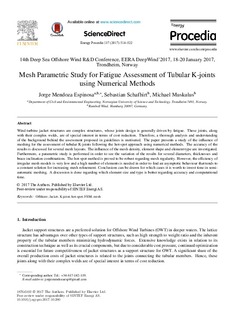| dc.contributor.author | Mendoza Espinosa, Jorge | |
| dc.contributor.author | Schafhirt, Sebastian | |
| dc.contributor.author | Muskulus, Michael | |
| dc.date.accessioned | 2017-12-20T14:23:33Z | |
| dc.date.available | 2017-12-20T14:23:33Z | |
| dc.date.created | 2017-12-19T11:28:34Z | |
| dc.date.issued | 2017 | |
| dc.identifier.citation | Energy Procedia. 2017, 137 514-522. | nb_NO |
| dc.identifier.issn | 1876-6102 | |
| dc.identifier.uri | http://hdl.handle.net/11250/2473345 | |
| dc.description.abstract | Wind turbine jacket structures are complex structures, whose joints design is generally driven by fatigue. These joints, along with their complex welds, are of special interest in terms of cost reduction. Therefore, a thorough analysis and understanding of the background behind the assessment proposed in guidelines is motivated. The paper presents a study of the influence of meshing for the assessment of tubular K-joints following the hot-spot approach using numerical methods. The accuracy of the results is discussed for several mesh layouts. The influence of the mesh density, element shape and element type are investigated. Furthermore, a parametric study is performed in order to see the variation of the results for several diameters, thicknesses and brace inclination combinations. The hot-spot method is proved to be robust regarding mesh regularity. However, the efficiency of irregular mesh models is very low and a high number of elements is needed in order to find an asymptotic behaviour that tends to a constant solution for increasing mesh refinement. Conclusions can be drawn for which cases it is worth to invest time in semiautomatic meshing. A discussion is done regarding which element size and type is better regarding accuracy and computational time. | nb_NO |
| dc.language.iso | eng | nb_NO |
| dc.publisher | Elsevier | nb_NO |
| dc.rights | Attribution-NonCommercial-NoDerivatives 4.0 Internasjonal | * |
| dc.rights.uri | http://creativecommons.org/licenses/by-nc-nd/4.0/deed.no | * |
| dc.title | Mesh parametric study for fatigue assessment of tubular K-joints using numerical methods | nb_NO |
| dc.type | Journal article | nb_NO |
| dc.type | Peer reviewed | nb_NO |
| dc.description.version | publishedVersion | nb_NO |
| dc.source.pagenumber | 514-522 | nb_NO |
| dc.source.volume | 137 | nb_NO |
| dc.source.journal | Energy Procedia | nb_NO |
| dc.identifier.doi | 10.1016/j.egypro.2017.10.380 | |
| dc.identifier.cristin | 1529536 | |
| dc.description.localcode | © 2017 The Author(s). Published by Elsevier Ltd. This is an open access article under the CC BY-NC-ND license (http://creativecommons.org/licenses/by-nc-nd/4.0/). | nb_NO |
| cristin.unitcode | 194,64,91,0 | |
| cristin.unitname | Institutt for bygg- og miljøteknikk | |
| cristin.ispublished | true | |
| cristin.fulltext | original | |
| cristin.qualitycode | 1 | |

